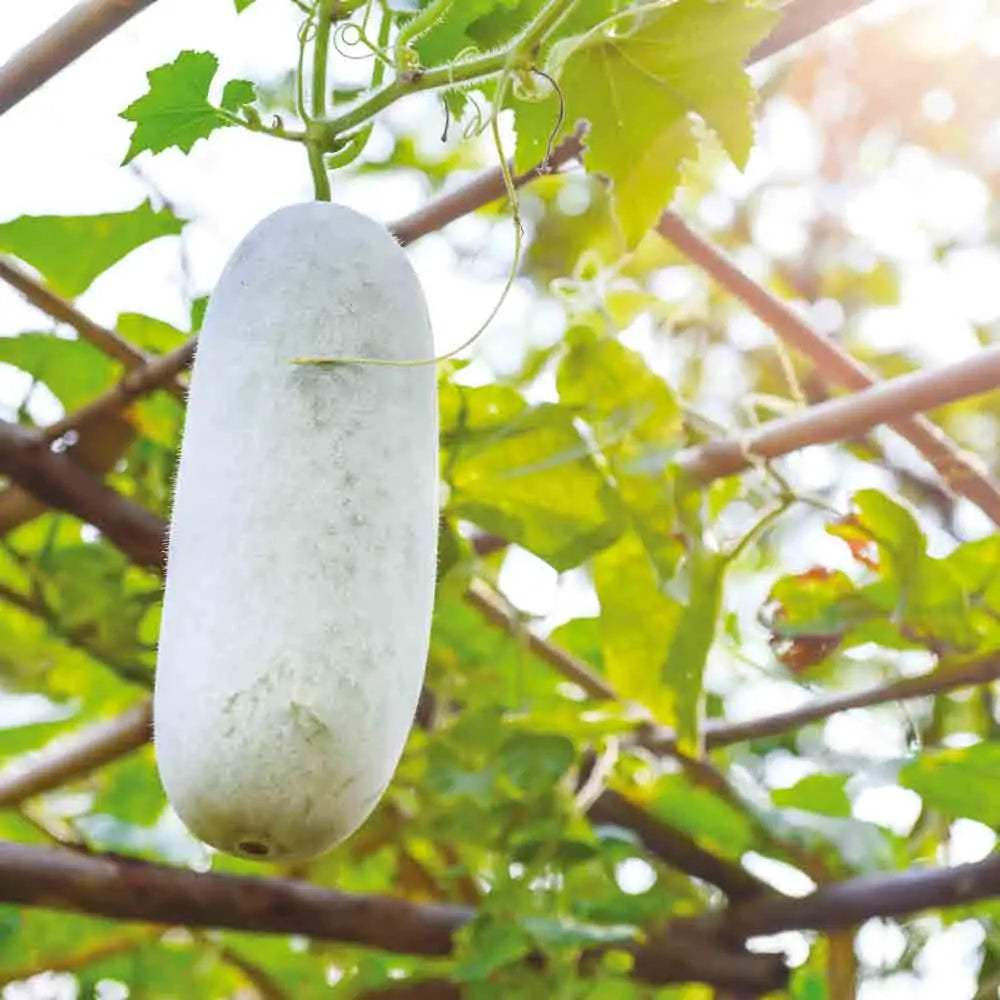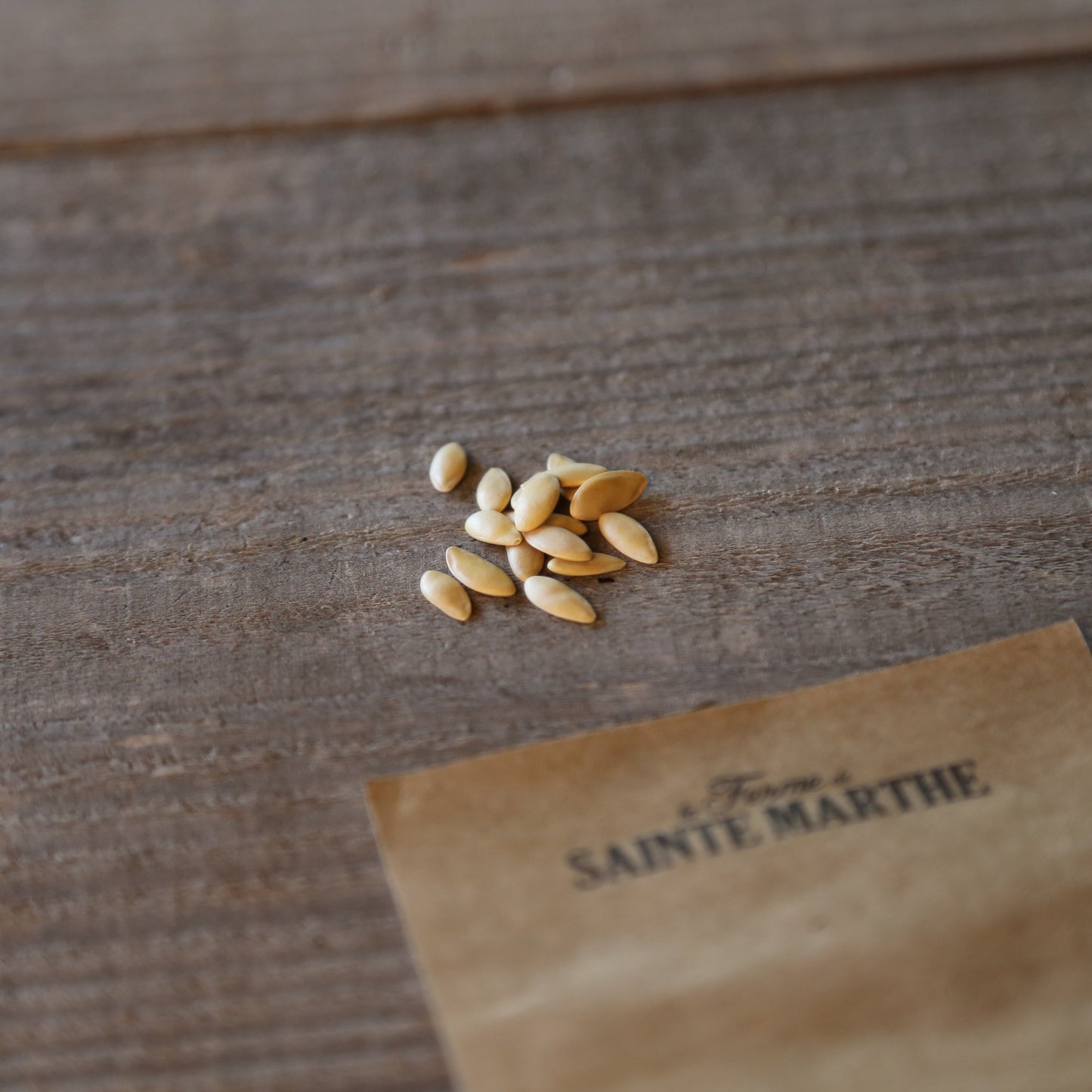WINTER MELON FENPIDONGGUA AB
Benincasa hispida
Fenpidonggua winter melon is a local Chinese variety from Changsha city. It is late-ripening and vigorous, producing large cylindrical fruits 65-70 cm long and 20-25 cm in diameter, weighing between 15 and 25 kg . Its hairy skin is covered with a white wax when ripe, and its flesh is white in color. This variety is heat-resistant and keeps well.
In China, it is commonly eaten cooked in a wok , in soup , stuffed , or steamed . It is also traditionally used as a preserve or drink . An interesting recipe to try: replace the zucchini with this melon in a ratatouille .
Successful Melon Sowing
Melon seedlings in pots
Melons need plenty of heat (between 24 and 35°C ) and light to germinate. The temperature during the day should be within this range, and not drop below 15°C at night. Ideally, you should sow your seeds in a warm frame or heated greenhouse in March/April and replant them in the garden after mid-May , once the risk of frost has passed.
- Sow 2 or 3 seeds (point downwards) per pot filled with fine seed compost, 1 cm deep .
- Water regularly to keep the soil moist (but not soggy) with a sprayer.
- Place the pots near a window or in bright light. As soon as the seedlings are out, make sure they receive plenty of light .
- Remove the weakest plants and keep only the most vigorous ones.
Melon seedlings in place
This method is more suitable for people living in the south of France or in Mediterranean climates , where it is possible to sow directly in the ground.
- Space the seeds 80 cm to 1 m between each melon plant.
- Place 2 to 3 seeds per pocket 1.5 cm deep , and cover them with a mixture of sifted garden soil and mature compost .
- Use a cloche or a frame to shelter the seedlings at the beginning of the growing season.
- Keep only the most beautiful plant for later.
Melon Plantation
Young plants can be planted between April and mid-June , depending on your region. If you are in a cooler region, using a plastic tunnel or a heated greenhouse is strongly recommended to maintain the warmth necessary for their development.
- Ensure a spacing of 80 cm to 1 m between each plant.
- Melons prefer a sunny location , rich, deep, well-aerated soil, with a good potash content. Don't hesitate to loosen the soil a little and add compost before planting.
Vegetable Garden Association
Melon grows well with most vegetables , except cucumbers and squash . Avoid planting these vegetables nearby.
Melon Culture
Newer melon varieties do not require pruning except for topping (cutting off the head). As soon as the plant has formed 4 to 6 leaves , prune the main stem to encourage good branching and more abundant fruiting.
- Watering should be regular but moderate, as excess water could harm the taste of the fruit. Do not wet the foliage to avoid the appearance of powdery mildew .
- Weed after planting to avoid competition, then mulch when the soil is warm (end of June-beginning of July).
- Remove leaves that shade the fruit to give them maximum sunlight.
- Place boards or tiles under the fruit to protect it from soil moisture and provide additional warmth.
Melon Harvest
Melons are harvested about 2-3 months after transplanting. The fruit color becomes paler, and the stem should begin to peel off easily. The aroma becomes more pronounced, and a small crack at the base of the fruit indicates that it is ready to peel.
Important: Do not store the melon in the refrigerator, as this will alter its aromas.
Melon Diseases
Melon is vulnerable to mildew , leaf spot , and powdery mildew . It is crucial to avoid watering the foliage, especially late in the day, to prevent infections, especially during stormy periods.
The main pests are aphids and seed flies . To avoid fly attacks, it is recommended to plant when temperatures are high enough to allow rapid plant growth.
At the end of the season, protect the melons by placing a tile or board under each fruit to protect them from soil moisture.









